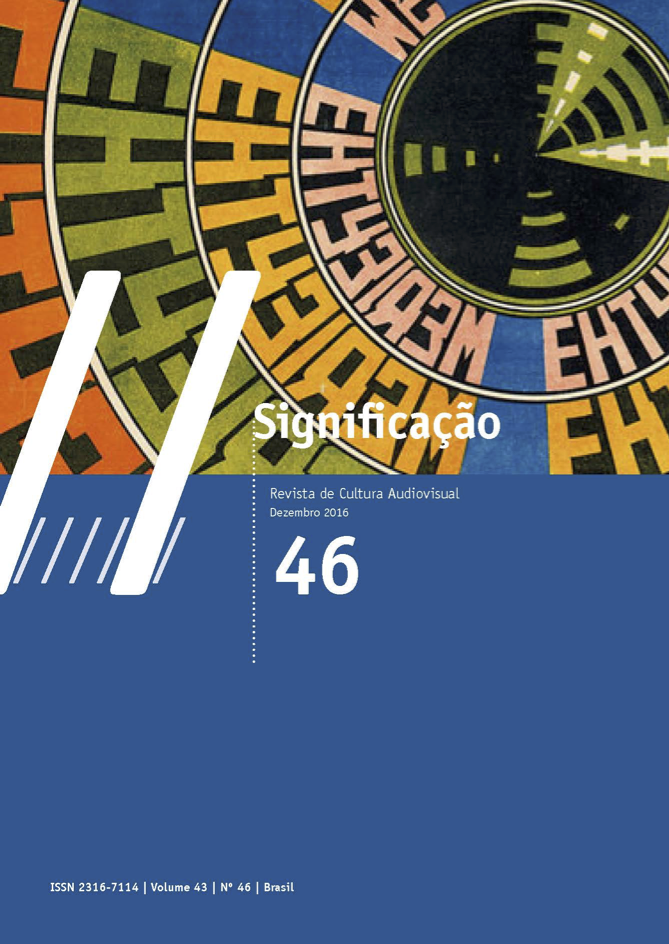Body and voice in the contemporary cinema: considerations about Spike Jonze’s movie Her (2013)
DOI:
https://doi.org/10.11606/issn.2316-7114.sig.2016.120992Keywords:
contemporary cinema, voice, body, JonzeAbstract
This paper intends to reflect about the film Her (Spike Jonze, 2013), considering the antinomies body /voice; visible/invisible; human/machine. In a dialogue between the theories of cinematic device and psychoanalysis, we will try to demonstrate that the narrative of Her presents a complex correspondence between body and voice. Analyzing the dynamics between the presence of the voice and the absence of Samantha's body on the scene, we seek to discuss about the new economy of forces between image and voice that the film operates. Finally, we intend to focus on the indeterminate boundaries that separate human and machine, since love in Her ceases to be a genuine human ability.
Downloads
References
AUMONT, J. Du visage au cinéma. Paris: Ed. Cahiers du cinéma, 1997.
BOLOGNA, C. “Voz” (verbete). In: BOLOGNA, C. Enciclopédia Einaudi. Lisboa: Imprensa Nacional/Casa da Moeda, 1987.
CHION, M. El Sonido: música, Cine, Literatura. Barcelona: Paidós, 1998.
DELEUZE, G. Cinema 1: a imagem-movimento. São Paulo: Brasiliense, 1985.
______. Cinema 2: a imagem-tempo. São Paulo: Brasiliense, 2009.
DOANE, M-A. “A voz do cinema: a articulação entre corpo e espaço”. In: XAVIER, I. (org). A Experiência do Cinema. Rio de Janeiro: Graal, 1983.
GAS, G. Her. Courte-Focale.fr: Grand Angle sur le Cinéma (2014). Disponível online em: <http://www.courte-focale.fr/cinema/critiques/her-spike-jonze/>. Acesso em 06 fev. 2016.
HARAWAY, D. “Manifesto Ciborgue: Ciência, tecnologia e feminismo-socialista no final do século XX” In. HARAWAY, D.; KUNZRU, H.; TADEU, T. Antropologia do Ciborgue: as Vertigens do Pós-humano. Belo Horizonte: Autêntica, 2002.
MOISÉS, M. “O ponto de vista”. In: MOISÉS, M. A análise literária. São Paulo: Cultrix, 2002.
MONDZAIN, M-J. (org). Voir Ensemble: autour de Jean-Toussaint Desanti. Col. l'exception, réfléchir le cinéma. Paris: Galimard, 2003.
_______. Homo Spectator. Paris: Bayard, 2007.
_______. Images: (à suivre). De la poursuite au cinéma et ailleurs. Paris: Bayard, 2011.
_______. “A Imagem entre proveniência e destinação”. In: ALLOA, Emmanuel. Pensar a Imagem. São Paulo: Autêntica, 2015.
MORIN, E. Le cinéma ou l'homme imaginaire. Paris: Les éditions de minuit, 1956.
MULVEY, L. “Prazer Visual e Cinema Narrativo”. In: XAVIER, I. (org). A Experiência do Cinema. Rio de Janeiro: Graal, 1983.
ROSENMULLER, S. The Person from Arendt's Perspective. Hannah Arendt's Center (2012). Disponível online em: <http://www.hannaharendtcenter.org/?tag=stefanie-rosenmuller>. Acesso em 06 jun. 2015.
SIBILIA, P. “Rumo à imortalidade e à virtualidade: A construção científico-tecnológica do homem pós-orgânico”. INTERCOM – Sociedade Brasileira de Estudos Interdisciplinares da Comunicação XXIV Congresso Brasileiro da Comunicação – Campo Grande /MS – setembro 2001. Disponível online em: <http://www.intercom.org.br/papers/nacionais/2001/papers/NP8SIBILIA.PDF>. Acesso em 17 fev. 2016.
VERNET, M. Figures de l'absence de l'invisible au cinéma. Paris: Cahiers du Cinéma, 1988.
XAVIER, I. O Discurso Cinematográfico: a opacidade e a transparência. São Paulo: Paz e Terra, 2008.
Referências Audiovisuais
A.I. (Inteligência Artificial). Steven Spielberg, EUA, 2001.
ADAPTATION (Adaptação). Spike Jonze, EUA, 2002.
BEING John Malkovich (Quem quer ser John Malkovich). Spike Jonze, EUA, 1999.
BICENTENNIAL Man (O Homem bicentenário). Chris Columbus, EUA, 1999.
BLADE Runner (Blade Runner, o caçador de androides). Ridley Scott, EUA, 1982.
I, Robot (Eu, Robô). Alex Proyas, EUA, 2004.
LOST in translation (Encontros e Desencontros). Sofia Coppola, EUA, 2003.
METROPOLIS (Metrópolis). Fritz Lang, Alemanha, 1927.
ROBOCOP (Robocop). Paul Verhoeven, EUA, 1987.
STAR Wars (Guerra nas Estrelas). Criador: George Lucas, 1977.
WHERE the wild things are (Onde vivem os monstros). Spike Jonze, EUA, 2009.
WIZARD of Oz (O Mágico de Oz). Victor Flemming, EUA, 1939.
Downloads
Published
Issue
Section
License
Copyright (c) 2016 Henrique Codato

This work is licensed under a Creative Commons Attribution-NonCommercial 4.0 International License.
Authors who publish in this journal must agree with the following terms:
- Authors keep their copyrights and grant the journal first time publication rights, having their articles simultaneously licensed under the Creative Commons Attribution License, which allows sharing texts with authorship recognition and first publication on this journal for non-commercial purposes.
- Authors are allowed to make additional contracts, for a non-exclusive distribution of the article’s version published on this journal (e.g.: publishing in institutional repositories of articles or as a book chapter), with authorship recognition and first publication on this journal.
















